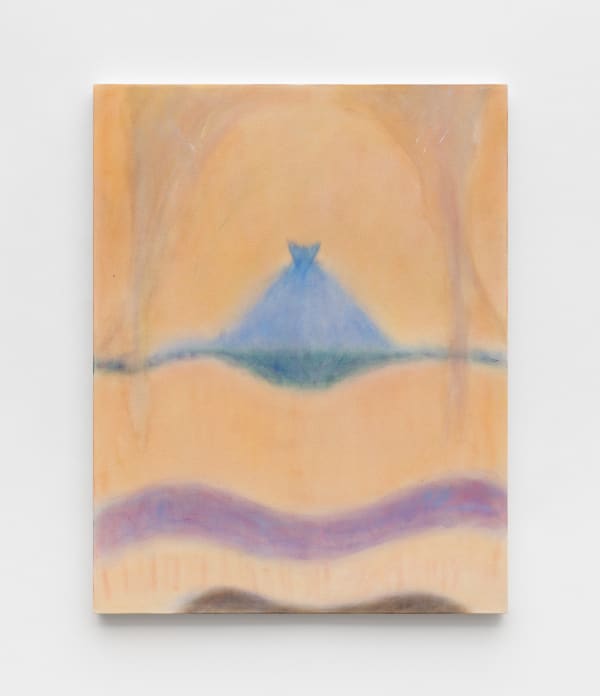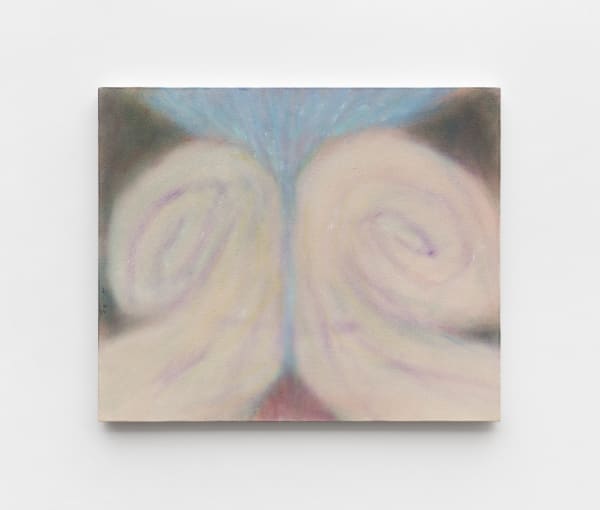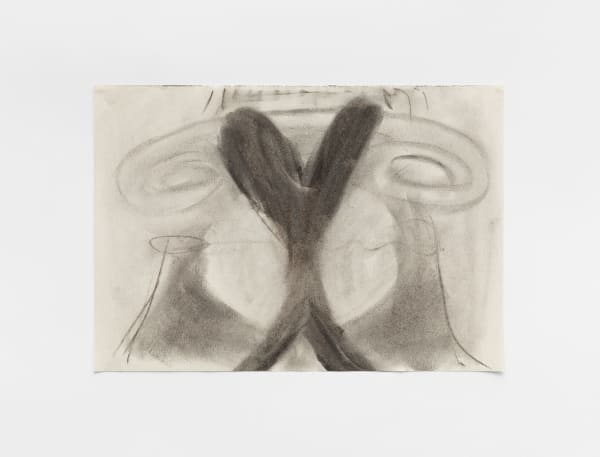Above the focus, behind the ear Akiko Kinugawa
Yudi Rafael: Let’s begin with the title of your show. Above the focus, behind the ears can sound enigmatic or even nonsensical, but it alludes to embodied, sensorial perception. You have mentioned that it stems from your practice of mapping the body parts that are activated when you try to see and hear things in a vague way. What does it mean to experience the world through this mode of perception?
Akiko Kinugawa: I chose this title from an exercise of locating the area of my brain that is activated when I look at my work or at other things. When I look vaguely at something that I am faced with, my eyes lie on a single point, and, instead of focusing clearly on any substance, my consciousness seems to spread above and behind my ears. When I began to paint, I didn’t know what was consciousness. I didn’t know where it was located, but I could feel it was there, and it seems to be there for others too. It always depends on one’s beliefs and on the worldviews that predominate at a certain time and place. You can’t see it, even if you think you can. I have a desire to be immersed in that realm, to loosen some of the certainties I have about the world.
YR: How does vagueness relate with consciousness?
AK: The image of consciousness for me is that of a floating, moving stream. When I paint, I give great importance to the sensations one gets when facing a painting. I want to create the sensation of facing a vague shape, of the vague shape floating. I paint by repeatedly rubbing oil on a cotton cloth, and only the convex parts of the uneven cotton cloth are covered with color, making them look like tiny dots of color. The loose shape of these dots gives the sensation that they are moving. While looking at them for a long time, the colors sometimes feel like sounds that I cannot grasp with my ears.
YR: The idea of hearing colors makes me think of synesthesia. Does translating impressions across different sensorial registers also permeate other elements of your work, like the use of texture or geometric and organic shapes?
AK: I feel that cotton fabric is like skin. Painting for me is like sewing energy into the material. I don’t consider the texture according to the object I depict, but I’m interested in the relationship between materiality and consciousness. Maybe that sensation of synesthesia is there. When I draw a picture and look at it for a long time, it can feel like it’s talking, like it’s making an inaudible sound.
YR: You have mentioned on another occasion that your visits to Shinto shrines across Japan have been key to your current understanding of consciousness and its relationship with the sensorial perception that you bring to your paintings.
AK: I visit Shinto shrines mostly on mountains in the countryside. They are places where nature worship remains. There are trails that you follow to reach the innermost shrine, torii paths surrounded by forest, and you hear a lot of sounds while walking to the shrine. Once there, you pray in front of a mirror, where you and your surroundings are reflected. It seems to say that God is not in the shrine, but in you and everything around you. I feel that my body is not separated from things around me.
YR: In hole and blue ▽, the titles of your works clearly refer to formal elements in these paintings, things that one can see. 1-2-3 (Hi Hu Mi) follows the same logic, but as if stemming from a playful interaction with what one can see in the work, counting some of its highlighted forms. A title like 22to3, however, seems to follow a different, coded register. Can you elaborate on these choices?
AK: Before, my works did not have titles. But since I changed my focus from human faces to other things, I started giving them titles. In my current painting there is intention behind the motifs. The titles relate to the motifs I use in my works, as well as the symbols and numbers that are part of it.
The painting 22to3 has an image of Mount Fuji. The sound of the word Fuji can be equivalent as of that of the number two – fu or ji. Fu is an old way of reading the number, and ji can also mean two, but in kanji. It’s a wordplay. The sound of three is san, which can also refer to a volcano mountain related to the sun, Haleakalā. The image of that mountain appears under Mt. Fuji, creating a connection. The title of Call in, on the other hand, references the kanji for “breathing.” This kanji combines two different ones: yobu, which means to call, and suu, which means to inhale. For the painting, I use the forms of lungs and sought to create the impression of the act of breathing. I also sought to convey water and ended up drawing the left and right lungs as separate consciousnesses. The idea was to layer images of different parts of the human body and also consciousness, blurring their boundaries.
When I think of titles for my works, I draw from old Japanese culture, that is, mythology and chants. Japanese mythology can be quite complex to follow, with men and women switching roles without anyone noticing. Similarly, many old chants seem to be just random uses of the sounds of the fifty syllables available in the language, rearranged into different words. There are many ambiguous stories in Japanese mythology and chants, their meanings lost in time, and I’m interested in how they dissolve boundaries. In mythology, the form of my body, like its size or gendered parts, and my existence in itself vanish. In chanting, the order of sounds changes, and you can’t understand what’s happening just by listening. The contours of meaning fade.
-
 Akiko Kinugawa, 1・2・3 (Hi Hu Mi), 2025
Akiko Kinugawa, 1・2・3 (Hi Hu Mi), 2025 -
 Akiko Kinugawa, blue▽, 2025
Akiko Kinugawa, blue▽, 2025 -
 Akiko Kinugawa, hole, 2025
Akiko Kinugawa, hole, 2025 -
 Akiko Kinugawa, u, 2025
Akiko Kinugawa, u, 2025 -
 Akiko Kinugawa, 22to3, 2025
Akiko Kinugawa, 22to3, 2025 -
 Akiko Kinugawa, call in, 2025
Akiko Kinugawa, call in, 2025 -
 Akiko Kinugawa, A-Wa, 2025
Akiko Kinugawa, A-Wa, 2025 -
 Akiko Kinugawa, Untitled | Sem título, 2025
Akiko Kinugawa, Untitled | Sem título, 2025 -
 Akiko Kinugawa, Untitled | Sem título, 2025
Akiko Kinugawa, Untitled | Sem título, 2025 -
 Akiko Kinugawa, Untitled | Sem título, 2025
Akiko Kinugawa, Untitled | Sem título, 2025 -
 Akiko Kinugawa, Untitled | Sem título, 2025
Akiko Kinugawa, Untitled | Sem título, 2025 -
 Akiko Kinugawa, Untitled | Sem título, 2025
Akiko Kinugawa, Untitled | Sem título, 2025 -
 Akiko Kinugawa, Untitled | Sem título, 2025
Akiko Kinugawa, Untitled | Sem título, 2025 -
 Akiko Kinugawa, Untitled | Sem título, 2025
Akiko Kinugawa, Untitled | Sem título, 2025 -
 Akiko Kinugawa, Untitled | Sem título, 2025
Akiko Kinugawa, Untitled | Sem título, 2025 -
 Akiko Kinugawa, Untitled | Sem título, 2025
Akiko Kinugawa, Untitled | Sem título, 2025 -
 Akiko Kinugawa, Untitled | Sem título, 2025
Akiko Kinugawa, Untitled | Sem título, 2025 -
 Akiko Kinugawa, Untitled | Sem título, 2025
Akiko Kinugawa, Untitled | Sem título, 2025 -
 Akiko Kinugawa, Untitled | Sem título, 2025
Akiko Kinugawa, Untitled | Sem título, 2025 -
 Akiko Kinugawa, Untitled | Sem título, 2025
Akiko Kinugawa, Untitled | Sem título, 2025





















